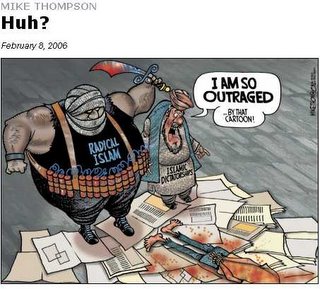
The following two articles by Amir Taheri offer useful information about understanding the beliefs of Islam, and how they relate to politics, historically and currently. The article at the end by Jack Kelly ties in nicely with how and why this is being handled (or mishandled) by the MSM, with many international references.
BONEFIRE OF THE PIETIES
Islam prohibits neither images of Muhammad nor jokes about religion.
BY AMIR TAHERI
Wednesday, February 8, 2006 12:01 a.m. EST
"The Muslim Fury," one newspaper headline screamed. "The Rage of Islam Sweeps Europe," said another. "The clash of civilizations is coming," warned one commentator. All this refers to the row provoked by the publication of cartoons of the prophet Muhammad in a Danish newspaper four months ago. Since then a number of demonstrations have been held, mostly--though not exclusively--in the West, and Scandinavian embassies and consulates have been besieged.
But how representative of Islam are all those demonstrators? The "rage machine" was set in motion when the Muslim Brotherhood--a political, not a religious, organization--called on sympathizers in the Middle East and Europe to take the field. A fatwa was issued by Yussuf al-Qaradawi, a Brotherhood sheikh with his own program on al-Jazeera. Not to be left behind, the Brotherhood's rivals, Hizb al-Tahrir al-Islami (Islamic Liberation Party) and the Movement of the Exiles (Ghuraba), joined the fray. Believing that there might be something in it for themselves, the Syrian Baathist leaders abandoned their party's 60-year-old secular pretensions and organized attacks on the Danish and Norwegian embassies in Damascus and Beirut.
The Muslim Brotherhood's position, put by one of its younger militants, Tariq Ramadan--who is, strangely enough, also an adviser to the British home secretary--can be summed up as follows: It is against Islamic principles to represent by imagery not only Muhammad but all the prophets of Islam; and the Muslim world is not used to laughing at religion. Both claims, however, are false...
You can read the whole of this richly informative articleHERE.
In this article in the New York Post, Amir Tehari talks about what he calls Neo-Islam, a political movement masquerading as a religious faith.
HIJACKING ISLAM
By AMIR TAHERI
"GOD? What about him?" the sheik asked with a frown.
We were in a London mosque, discussing the ser mons the sheik delivers at Friday congregations. I had asked why God almost never featured in (or, at best, got a cameo role) in sermons that focused almost exclusively on political issues.
For the sheik, what mattered was "the sufferings of our brethren under occupation." In other words: In our Islam, we don't do God — we do Palestine, Kashmir and Iraq!
Here we have a religion without a theology, a secular wolf disguised as a religious lamb.
How did this neo-Islam — a political movement masquerading as religion — come into being, and how can those who know little about Islam distinguish it from the mainstream of the faith?
USING Islam as a vehicle for political ambitions is not new. The Umayyads used it after the Prophet's death to set up a dynastic rule. Three of the four caliphs who succeeded Muhammad were assassinated in the context of political power games presented as religious disputes...
You can read the whole piece HERE. (registration may be required to read the whole article, but it's worth it. It's filled with historical details that explain what we are dealing with now).
PROPHET AND LOSS
U.S. media's failure to print the Danish cartoons is craven
by Jack Kelly
The New York Times had an editorial Tuesday on the controversy triggered by publication in a Danish newspaper of 12 caricatures of the prophet Mohammed.
"The New York Times and much of the rest of the nation's news media have reported on the cartoons but refrained from showing them," the editors said. "That seems a reasonable choice for news organizations that usually refrain from gratuitous assaults on religious symbols."
The next day, in a story on the reaction to the Mohammed cartoons, the Times republished, gratuitously, an image of a work of "art" portraying the Virgin Mary adorned with elephant dung. (The painting by Chris Ofili, "Holy Virgin Mary," was the subject of much controversy when displayed at the Brooklyn Museum in 1999.) In 1989, the Times was one of many newspapers that published an image of "Piss Christ," a photograph by artist Andres Serrano showing Christ on a crucifix submerged in a vat of urine.
Washington Post Executive Editor Len Downie told Editor & Publisher he wouldn't publish the Danish cartoons because of "general good taste." Had Mr. Downie developed his good taste a week earlier, the Post might not have published a Tom Toles editorial cartoon of a quadruple amputee soldier so vile all six members of the Joint Chiefs of Staff wrote a letter to the editor protesting it.
Most in the news media don't mind offending people who express their outrage by writing letters to the editor. But when the offended threaten to cut off the editor's head, editors become more "culturally sensitive."...
...Only extremist sects like the Wahhabis of Saudi Arabia think any depiction of Mohammed is blasphemy. But this isn't reported much, because if it were, it would be clear the media's self censorship is motivated more by cowardice than by conviction.
"Let no one pretend that the reason for this censorship isn't fear," wrote Andrew Bolt in the Melbourne (Australia) Herald Sun.
Bowing to the demands of Islamic radicals undermines Muslim moderates, Mr. Bolt said.
"This refusal to publish does not represent the success of multiculturalism but its failure," he said. "Habits of free speech good enough for generations of Christians, Sikhs, Buddhists and Jews are too much for Muslims whose anger scares even their leaders." ...
You can read the whole article HERE.
No comments:
Post a Comment